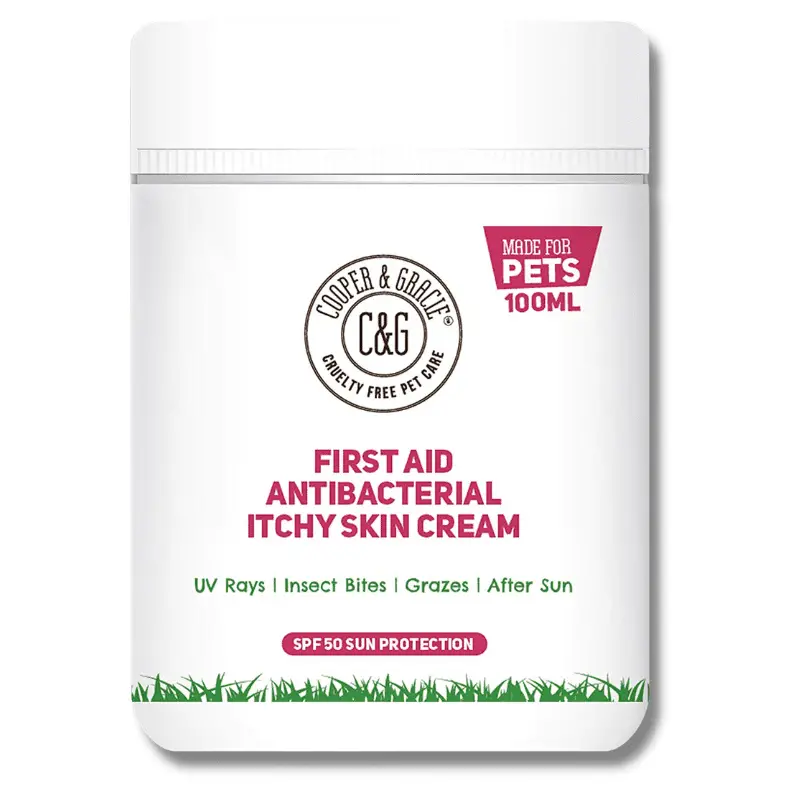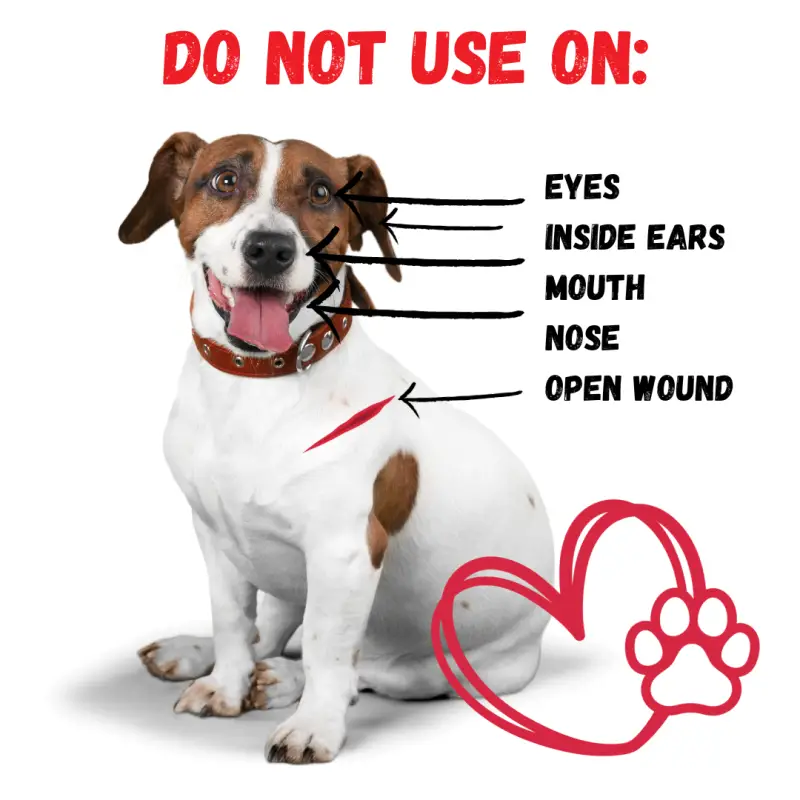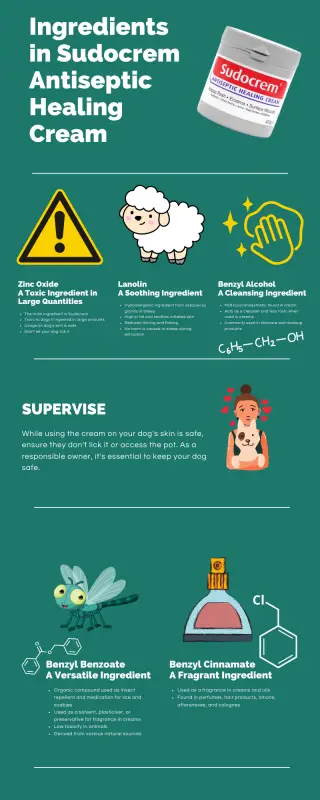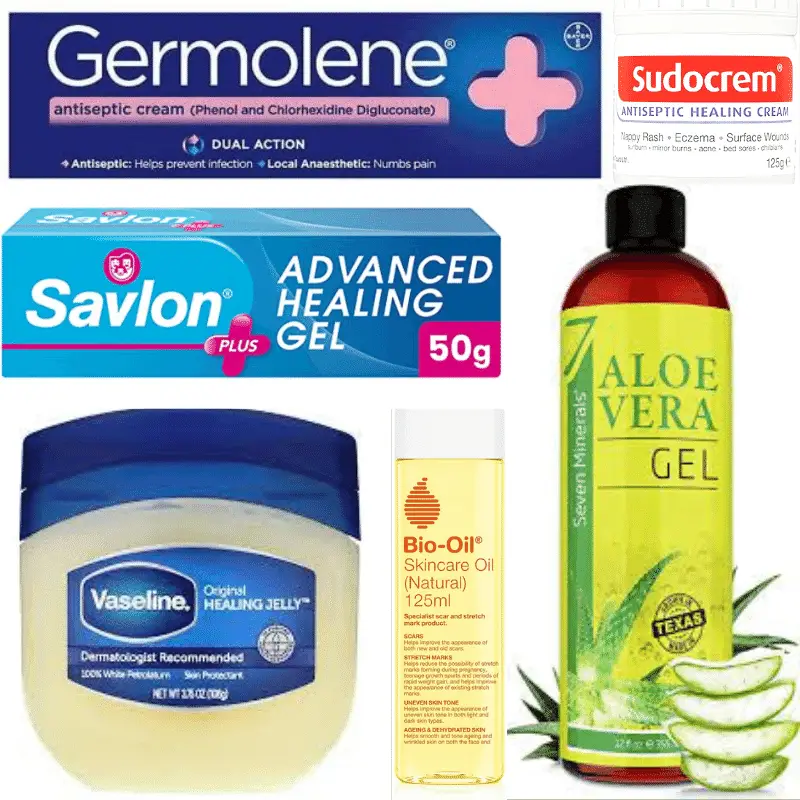If you are unsure about the safety of Sudocrem for your dog and want to know the best way to use it, you’ve found the right source. I have personally used Sudocrem on my dog when necessary. This article will provide all the necessary details to help you make an informed choice when considering using Sudocrem on your beloved pet.
My dog would scratch one spot a lot, even though there was no real problem with his skin. I didn’t have anything else in his first aid kit to help him, but luckily, I had Sudocrem. It worked well, and his skin sores improved in a few days. Sudocrem is suitable for all kinds of dogs for temporary use until a 100% dog-friendly cream is available.
What is Sudocrem?
Sudocrem is a medicated antiseptic cream initially developed in the UK in 1931. It is primarily used to treat nappy rash in babies but has many additional benefits and is highly versatile. However, can this cream be used on our furry friends? Let’s find out.
Is Sudocrem safe to use on dogs?
Sudocrem can be a great temporary solution for dogs when a dedicated antiseptic is unavailable. It can help treat minor skin irritations such as cuts, scrapes, and hot spots. However, it’s important to note that Sudocrem should only be used externally on unbroken skin and never applied to open wounds. It should also never be ingested by your dog.
One important thing to consider is if your dog likes to chew or lick itself, you must be careful about how much you use and where you put it. You must also ensure you use it correctly to avoid any harmful effects.
I have compiled a list of the best ways to use Sudocrem on your dog. If you follow these tips, your dog will get the best results from this healing cream.
The Right Way to Use Sudocrem Safely and Effectively
Following these instructions is vital to using Sudocrem safely. First, look at the recommended areas where you can apply the cream. You only need to use a small amount and gently rub it in. Do this a couple of times a day. If the area is sensitive, you can carefully dab it on instead. Please don’t use too much cream because your dog might try to lick it off. Also, be aware that Sudocrem is greasy and could leave marks on furniture. So, it’s a good idea to keep your dog off the sofa or bed when applying it. After a short time, the cream should absorb into the skin.

In what situations can Sudocrem be used for dogs?
While Sudocrem can be used on dogs, there are specific situations where it can be helpful—providing temporary relief for itching and discomfort caused by flea bites or allergies. Soothing and protecting the skin in areas such as the base of the tail, legs, paws, neck, head, back, belly, bum, outside of ears, around the genitals, and dog wrinkles.
Antiseptic Cream Made Specifically For Dogs
I am introducing an antiseptic cream alternative specially formulated for dogs that can be safely used for extended periods. Unlike other dog creams, this cream has a pleasant scent. I now keep a jar of this cream in my cabinet for my dogs’ long-term skin care needs.

C&G PETS | FIRST-AID ANTIBACTERIAL ITCHY SKIN CREAM WITH SPF 50 | 100% NATURAL ESSENTIAL OIL | MAINTAINS CRACKED ITCHY SKIN | LICK-SAFE NON-TOXIC NON-IRRITANT |HIGHLY ABSORBENT SUN CREAM FOR DOGS 100ML.
Considerations before using Sudocrem on your dog
Before applying Sudocrem to your dog, there are a few crucial factors to consider. Self-chewing or self-licking behaviour, Using it correctly, Unbroken skin, and Allergy or sensitivity should all be considered.
Areas where Sudocrem can be safely used on your dogs:
- Back
- Base of tail
- Belly
- Bum
- Dogs wrinkles
- Head
- Legs
- Neck
- Outside of ears
- Paws
- Tail
- Around the genitals
Areas to avoid using Sudocrem on your dogs:

- Eyes
- Inside Ears
- Mouth
- Nose
- Open Wound
Ideal for the following situations:
- Scratches caused by cats
- Bites from fleas
- Excessive itching
- Sores on paws
- Minor cuts on paws
- Sunburn
When To Apply Sudocrem
Applying Sudocrem to your dog’s wound can help with the healing process. However, using it at the right time and in the right amount is essential. Here are some guidelines to follow:
Clean the Wound: Before applying Sudocrem, thoroughly clean the wound. Use mild soap and water to gently wash away any dirt or debris. This step prevents infection and allows the cream to work effectively.
Avoid Nighttime Application: It is advisable not to apply Sudocrem on your dog’s wound at night. This is because your dog may lick the cream off or have an allergic reaction to it while you are asleep. To ensure the cream stays on the wound, it is best applied during the day when you can supervise your pet.
Avoid Long-term Use: While Sudocrem can be helpful in the short term, it is not recommended as a long-term solution. Continuous application of Sudocrem may delay the healing process or mask any underlying issues. If you need to apply a cream frequently, consider using an antiseptic cream specifically designed for dogs. These creams are formulated to address canine skin issues and are a better choice for extended use.
Consult a Veterinarian: It is always a good idea to consult your veterinarian before using new products on your dog’s wounds. They can provide tailored advice based on your dog’s specific needs. Your vet may recommend other treatments or suggest alternative creams that suit your dog’s condition.
The Amount to Use
A little goes a long way. Applying too much Sudocrem can cause issues for your dog. It may get onto their fur, making cleaning messy and difficult. Moreover, excessive application may clog the wound and prevent it from healing properly. Only use a thin layer of Sudocrem to cover the wound adequately. If it is not too painful, try to rub it or dab it carefully with clean fingers.
What is in Sudocrem antiseptic healing cream
Zinc Oxide: A Toxic Ingredient
One of the main ingredients in Sudocrem is zinc oxide, which is toxic to dogs if ingested in large amounts. While using the cream on your dog’s skin is safe, ensure they don’t lick it or access the pot. As a responsible owner, it’s essential to keep your dog safe.
Lanolin: A Soothing Ingredient
Lanolin is a hypoallergenic ingredient derived from the sebaceous glands of sheep. It is high in fat and helps soothe irritated skin, reducing itching and flaking. No harm is caused to sheep during extraction, as shearing is a routine procedure for their well-being.
Benzyl Alcohol: A Cleansing Ingredient
Benzyl Alcohol is a mild local anaesthetic found in the cream. It acts as a cleanser and is less toxic when used in creams. This ingredient is commonly used in skincare and makeup products.
Benzyl Benzoate: A Versatile Ingredient
Benzyl Benzoate is an organic compound primarily used as an insect repellent and medication for lice and scabies. Creams are also used as solvents, plasticisers, or fragrance preservatives. It has low toxicity in animals and is derived from various natural sources.
Benzyl Cinnamate: A Fragrant Ingredient
Benzyl Cinnamate is often used as a fragrance in creams and oils. It can be found in perfumes, hair products, lotions, aftershaves, and colognes.

Zinc Oxide Toxicosis: Recognising the Warning Signs
Since zinc oxide is a primary ingredient in Sudocrem, focusing on its potential toxicity is vital. Be aware that zinc oxide can be toxic if consumed in large quantities, so monitoring your dog when applying Sudocrem is crucial to avoid accidental ingestion. Watch for signs that your dog may have eaten some, and if it seems like a significant amount has been swallowed, get help from a vet.
Zinc oxide toxicosis can happen when the body is exposed to excess zinc, a mineral found in many substances. Several common signs can help us identify if someone is dealing with this condition.
Weakness: Individuals experiencing Zinc Oxide Toxicosis may feel unusually weak and lack energy. Simple tasks may become exhausting or challenging to perform.
Anaemia: Another noticeable sign is the development of anaemia. This condition occurs when the body lacks enough healthy red blood cells to carry oxygen efficiently, leading to fatigue and weakness.
Diarrhoea: Zinc Oxide Toxicosis can often result in diarrhoea episodes. Frequent loose or watery stools may occur, causing discomfort and dehydration.
Vomiting: Persistent or recurrent vomiting is another telltale sign of Zinc Oxide Toxicosis. This can disrupt the balance of fluids in the body and lead to further complications.
Lethargy: If someone seems excessively tired or experiences a significant lack of motivation, it could be a sign of Zinc Oxide Toxicosis. Lethargy, or extreme fatigue, can make it challenging to stay alert and engaged.
Weight Loss: Unexpected and significant weight loss can indicate Zinc Oxide Toxicosis. This occurs when the body’s metabolism is disrupted, leading to the shedding of pounds without apparent cause.
Cyanosis: Cyanosis is the bluish discolouration of the skin, nails, or lips caused by a lack of sufficient oxygen in the bloodstream. This symptom can be observed in severe zinc oxide toxicology cases, indicating a serious medical condition.
Awareness of these signs and promptly seeking medical attention, if any, is crucial in managing zinc oxide toxicosis in dogs and ensuring overall well-being.

Check these other products to see if they are safe for dogs.
Conclusion
In conclusion, Sudocrem can be used on dogs in specific situations as a temporary solution for minor skin irritations. However, it should only be applied externally on unbroken skin and never on open wounds. It is crucial to consider your dog’s behaviour and skin condition and consult a veterinarian before using Sudocrem or any new product on your pet. Always prioritise your dog’s safety and well-being.
Testimonial

Sudocrem: A Dog Mum’s Solution for Healthy Ears
From Peterborough, I’m grateful to Sudocrem for helping my dachshund Dexter. His ears were cracked and hurting. I used Sudocrem on his ears and saw quick improvement. They healed nicely! I also used a snood to keep his ears clean on walks. Sudocrem and the snood worked great together. Now Dexter is happy and healthy with all thanks to Sudocrem. For any dog mums dealing with similar problems, I highly recommend Sudocrem! Thanks, Sudocrem, for making Dexter’s life better!
— Dog Mum, Peterborough
